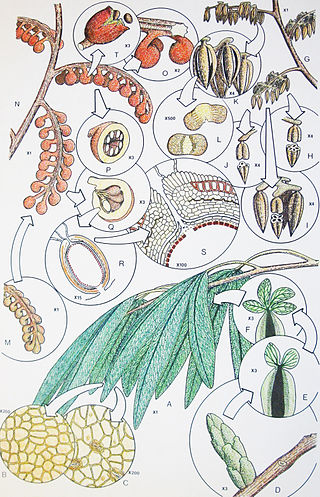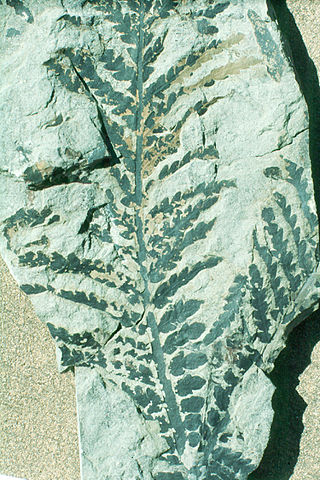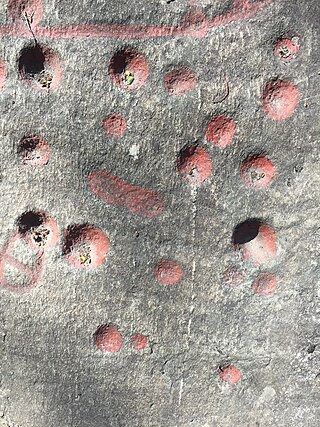The Mesozoic Era is the era of Earth's geological history, lasting from about 252 to 66 million years ago, comprising the Triassic, Jurassic and Cretaceous Periods. It is characterized by the dominance of gymnosperms like, cycads, ginkgoaceae and araucarian conifers and of archosaurian reptiles, such as the dinosaurs; a hot greenhouse climate; and the tectonic break-up of Pangaea. The Mesozoic is the middle of the three eras since complex life evolved: the Paleozoic, the Mesozoic, and the Cenozoic.
The Phanerozoic is the current and the latest of the four geologic eons in the Earth's geologic time scale, covering the time period from 538.8 million years ago to the present. It is the eon during which abundant animal and plant life has proliferated, diversified and colonized various niches on the Earth's surface, beginning with the Cambrian period when animals first developed hard shells that can be clearly preserved in the fossil record. The time before the Phanerozoic, collectively called the Precambrian, is now divided into the Hadean, Archaean and Proterozoic eons.

The Triassic is a geologic period and system which spans 50.5 million years from the end of the Permian Period 251.902 million years ago (Mya), to the beginning of the Jurassic Period 201.4 Mya. The Triassic is the first and shortest period of the Mesozoic Era and the seventh period of the Phanerozoic Eon. Both the start and end of the period are marked by major extinction events. The Triassic Period is subdivided into three epochs: Early Triassic, Middle Triassic and Late Triassic.

Cycads are seed plants that typically have a stout and woody (ligneous) trunk with a crown of large, hard, stiff, evergreen and (usually) pinnate leaves. The species are dioecious, that is, individual plants of a species are either male or female. Cycads vary in size from having trunks only a few centimeters to several meters tall. They typically grow slowly and have long lifespans. Because of their superficial resemblance to palms or ferns, they are sometimes mistaken for them, but they are not closely related to either group. Cycads are gymnosperms (naked-seeded), meaning their unfertilized seeds are open to the air to be directly fertilized by pollination, as contrasted with angiosperms, which have enclosed seeds with more complex fertilization arrangements. Cycads have very specialized pollinators, usually a specific species of beetle. Both male and female cycads bear cones (strobili), somewhat similar to conifer cones.

In the geologic timescale, the Middle Triassic is the second of three epochs of the Triassic period or the middle of three series in which the Triassic system is divided in chronostratigraphy. The Middle Triassic spans the time between 247.2 Ma and 237 Ma. It is preceded by the Early Triassic Epoch and followed by the Late Triassic Epoch. The Middle Triassic is divided into the Anisian and Ladinian ages or stages.

Cleithrolepis is an extinct genus of freshwater ray-finned fish that lived from the Induan age to the Anisian in what is now Australia and Libya. A species from Late Triassic Germany, C. brueckneri, was also ascribed to Cleithrolepis.

Chigutisauridae is an extinct family of large temnospondyls. The only genera recognized as belonging to Chigutisauridae at the current time are all from Gondwana. Chigutisaurids first appeared during the Early Triassic in Australia. During the Late Triassic they became widely distributed in Gondwana, with fossils found in South Africa, India and South America. Koolasuchus from the Early Cretaceous of Australia represents the youngest known temnospondyl.

Gondwana was a large landmass, sometimes referred to as a supercontinent. The remnants of Gondwana make up around two-thirds of today's continental area, including South America, Africa, Antarctica, Australia, Zealandia, Arabia, and the Indian Subcontinent.

Brachyopoidea is a superfamily of temnospondyls that lived during the Mesozoic. It contains the families Brachyopidae and Chigutisauridae. The earliest records of brachyopids are from the Lower Triassic in Australia. The latest-surviving member of the superfamily is the chigutisaurid Koolasuchus from the Early Cretaceous of Australia.

The Caytoniales are an extinct order of seed plants known from fossils collected throughout the Mesozoic Era, around 252 to 66 million years ago. They are regarded as seed ferns because they are seed-bearing plants with fern-like leaves. Although at one time considered angiosperms because of their berry-like cupules, that hypothesis was later disproven. Nevertheless, some authorities consider them likely ancestors or close relatives of angiosperms. The origin of angiosperms remains unclear, and they cannot be linked with any known seed plants groups with certainty.

Myosaurus is a genus of dicynodont synapsids. Myosaurus was a small, herbivorous synapsid that existed around the early Triassic period. All of the fossils found of this species were found in Antarctica and South Africa. Compared to other fossils found from species that existed during this time, the Myosaurus is not common in the fossil record. This is due to a shortage of discovered fossils that possess characteristics unique to the Myosaurus. Notably, under 130 fossil fragments have been found that have been classified as Myosauridae, and almost all have been skulls. These skulls can be classified as Myosaurus because this species, unlike other dicynodonts, do not possess tusks or postfrontal teeth. The only species identified in the family Myosauridae is the Myosaurus gracilis, or M. gracilis. It should be recognized that the Myosaurus is almost always referred to as the M. gracilis in scientific research.

The Lyginopteridales are an extinct group of seed plants known from the Paleozoic. They were the first plant fossils to be described as pteridosperms and, thus, the group on which the concept of pteridosperms was first developed; they are the stratigraphically oldest-known pteridosperms, occurring first in late Devonian strata; and they have the most primitive features, most notably in the structure of their ovules. They probably evolved from a group of Late Devonian progymnosperms known as the Aneurophytales, which had large, compound frond-like leaves. The Lyginopteridales became the most abundant group of pteridosperms during Mississippian times, and included both trees and smaller plants. During early and most of middle Pennsylvanian times the Medullosales took over as the more important of the larger pteridosperms but the Lyginopteridales continued to flourish as climbing (lianescent) and scrambling plants. However, later in Middle Pennsylvanian times the Lyginopteridales went into serious decline, probably being out-competed by the Callistophytales that occupied similar ecological niches but had more sophisticated reproductive strategies. A few species continued into Late Pennsylvanian times, and in Cathaysia and east equatorial Gondwana they persisted into the Late Permian, but subsequently became extinct. Most evidence of the Lyginopteridales suggests that they grew in tropical latitudes of the time, in North America, Europe and China.

Dicroidium is an extinct genus of fork-leaved seed plants. It is the archetypal genus of the corystosperms, an extinct group of seed plants, often called "seed ferns", assigned to the order Corystospermales or Umkomasiales. Species of Dicroidium were widely distributed and dominant over Gondwana during the Triassic. Their fossils are known from South Africa, the Arabian Peninsula, Australia, New Zealand, South America, Madagascar, the Indian subcontinent and Antarctica.

Umkomasia is a genus of seed bearing organs produced by corystosperm seed ferns, first based on fossils collected by Hamshaw Thomas from the Burnera Waterfall locality near the Umkomaas River of South Africa. He recognized on the basis of cuticular similarities that the same plant produced pollen organs Pteruchus and the leaves Dicroidium. Various other corystosperm seed bearing organs from the Jurassic and Cretaceous have been assigned to this genus, but recently have been given distinct genera, with Umkomasia being restricted to the Triassic.

Pteruchus barrealensis is an unusually large species of Pteruchus with very elongate polleniferous heads from Early Triassic of Australia and Argentina.

Dicroidium zuberi is a large bipinnate species of the seed fern Dicroidium with a forked rachis. The leaves are affiliated with Umkomasia feistmantellii megasporophylls and Petruchusbarrealensis microsporophylls.

Pteruchus is a form genus for pollen organs of the seed fern (Pteridospermatophyta family Umkomasiaceae. It was first described by Hamshaw Thomas from the Umkomaas locality of South Africa. It is associated with the seed bearing organs Umkomasia and Dicroidium leaves.

Corystosperms are a group of extinct seed plants belonging to the family Corystospermaceae assigned to the order Corystospermales or Umkomasiales. They were first described based on fossils collected by Hamshaw Thomas from the Burnera Waterfall locality near the Umkomaas River of South Africa. Corystosperms are typified by a group of plants that bore forked Dicroidium leaves, Umkomasia cupulate ovulate structures and Pteruchus pollen organs, which grew as trees that were widespread over Gondwana during the Middle and Late Triassic. Other fossil Mesozoic seed plants with similar leaf and/or reproductive structures have also sometimes been included within the "corystosperm" concept sensu lato, such as the "doyleoids" from the Early Cretaceous of North America and Asia. A potential corystosperm sensu lato, the leaf genus Komlopteris, is known from the Eocene of Tasmania, around 53-50 million years old, over 10 million years after the Cretaceous–Paleogene extinction event.

Rock cupules are artificially made depressions on rock surfaces that resemble the shape of an inverse spherical cap or dome. They were made by direct percussion with hand-held hammer-stones, on vertical, sloping or horizontal rock surfaces. Cupules are widely believed to be the world's most common rock art motifs, found in huge numbers in every continent except Antarctica. They were produced in many cultures, from the Lower Paleolithic to the 20th century, and they can be found on most lithologies. Similar artifacts from lithic Native American cultures are also known as cupstones.

Komlopteris is an extinct genus of "seed fern" with possible corystosperm affinities. Fossils have been found across both hemispheres, dating from the latest Triassic to the early Eocene (Ypresian), making it the youngest "seed fern" in the fossil record.



















